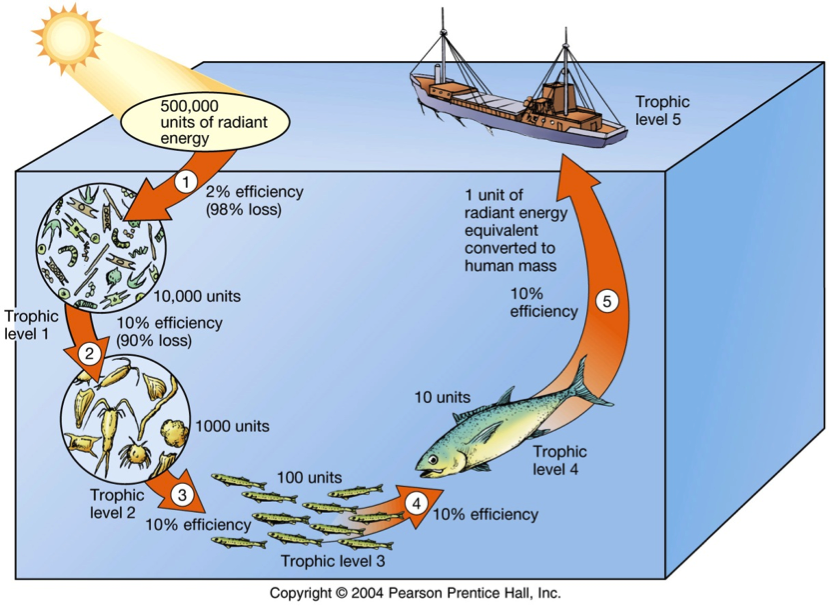- All living things require energy in order to survive and carry out their life processes, such as growth, reproduction and for their metabolism. For example, when thinking about our Ocean Tracks species, a large amount of energy is required to migrate the thousands of miles they may travel.
- This energy comes from the organism’s ecosystem and in many cases from the food that organism eats. But where did the energy in those food sources come from?
- For much of the life on Earth, the primary source of energy is from the sun. Through photosynthesis, plants are able to capture energy from sunlight and use that energy to power reactions that transform carbon dioxide and water into oxygen and sugar molecules. This process removes carbon dioxide from the atmosphere and provides the oxygen that we breathe.
- Life is possible, however, even in the absence of sunlight. For example, microbes living in hydrothermal vent communities are able to use inorganic chemical compounds through a process known as chemosynthesis to create energy. These chemosynthetic microbes are the foundation of the food web in hydrothermal vent communities. Photosynthesis and chemosynthesis make it possible for life to exist on Earth!
- Organisms that are able to capture energy either from sunlight or chemicals and convert it into a form that other organisms can use are called autotrophs.
- Autotrophs are also known as primary producers, and are are a highly important food source for other organisms. On land, primary producers are mostly plants such as grass in trees. In the ocean, 95% of the primary production is done by microscopic phytoplankton. Phytoplankton contribute 50% of the oxygen in our atmosphere. Some phytoplankton are bacteria and others are protists. Two important types of phytoplankton that are diatoms and dinoflagellates.
- In coastal regions of the ocean, algae, such as kelps and rockweeds, and plants, such as sea grasses, are important primary producers.
- For organisms that cannot make their own food, they must ingest other organisms to fulfill their energy requirements. These organisms are called heterotrophs. Heterotrophs are also called consumers because they must consume other organisms for energy and nutrients.
- Consumers obtain their energy in different ways:
- There are herbivores that feed on plant material. In the ocean, an example of an herbivore would be a periwinkle grazing on some algae.
- There are carnivores that kill and eat other animals. In the ocean, of course one of the greatest carnivores is the great white shark.
- There are scavengers and detritivores that feed on dead plants and animals, such as a hagfish feeding on a dead whale in the deep ocean.
- Omnivores feed on both plants and animals. The hawksbill sea turtle is an omnivore, feeding on sea urchins, mollusks, crustaceans and algae.
- Decomposers are bacteria that chemically break down organic matter.
- A food chain is a set of linkages that show who eats who in an ecosystem and the transfer of energy that takes place.
- Food chains start with a primary producer. Energy is then transferred to a primary consumer, then secondary, tertiary, and quaternary consumers in sequence.
- The primary consumer is an organism that eats a primary producer, which can include a zooplankton or snail in the ocean.
- The secondary consumer is an organism that eats a primary consumer, and includes fish species that feed on the zooplankton.
- Tertiary consumers feed on secondary consumers, and quaternary consumers feed on tertiary consumers. These groups include higher level predators such as sharks.
- In reality most ecosystems are more complicated than a simple chain of feeding interactions. Many species consume more than one type of species, creating a complex web of interactions known as a food web.
- In the visual below, you can see an example of a food web in the open ocean ecosystem and also one food chain that is a part of that food web. You may notice, however, that even the picture of the food web is incomplete since only a small number of ocean species are represented.

- Each step of the food web or chain is called a trophic level. Primary producers are always the first trophic level and are represented at the bottom of an ecological pyramid. The diagram below shows an example of an ecological pyramid for the ocean.

- These pyramids can also show how much energy is available at each trophic level of a food web. The average amount of energy transferred from one trophic level to the next is 10%. For example, 10% of the solar energy that is captured by phytoplankton gets passed on to zooplankton (primary consumers). Ten percent of that energy (10% of 10%, which is 1%) gets passed on to the organisms (secondary consumers) that eat the zooplankton.
- With more trophic levels that exist between the primary producer and a consumer, the smaller the amount of energy that gets passed on to the consumer. The shape of the pyramid reflects the idea that they amount of energy gets smaller as you move up the food chain. The visual below shows how little energy gets passed along as you get higher in the food chain.

Back to Top



